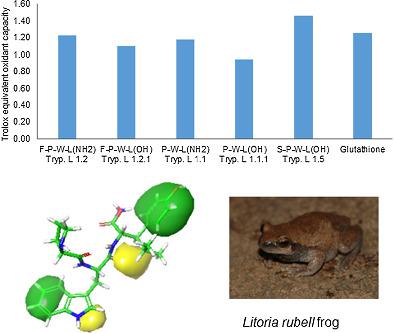当前位置:
X-MOL 学术
›
J. Pept. Sci.
›
论文详情
Our official English website, www.x-mol.net, welcomes your feedback! (Note: you will need to create a separate account there.)
Antioxidant activities of major tryptophyllin L peptides: A joint investigation of Gaussian‐based 3D‐QSAR and radical scavenging experiments
Journal of Peptide Science ( IF 2.1 ) Pub Date : 2021-01-06 , DOI: 10.1002/psc.3295 Thi Thanh Nha Tran 1 , Dinh Phien Tran 2 , Van Cuong Nguyen 1 , Thi Dieu Thuan Tran 1 , Thi Thu Thuy Bui , John Hamilton Bowie 3
Journal of Peptide Science ( IF 2.1 ) Pub Date : 2021-01-06 , DOI: 10.1002/psc.3295 Thi Thanh Nha Tran 1 , Dinh Phien Tran 2 , Van Cuong Nguyen 1 , Thi Dieu Thuan Tran 1 , Thi Thu Thuy Bui , John Hamilton Bowie 3
Affiliation

|
The red tree frog Litoria rubella from Australia has been studied for several decades showing that their dorsal skin glands secrete a number of small peptides containing a Pro–Trp sequence, known as tryptophyllin L peptides. Although peptides from many genera of Australian frogs have been reported to possess a variety of biological activities, the bioactivities of this peptide family have remained to be discovered. In this study, we investigated the antioxidant potency of a number of tryptophyllin L peptides for the first time using a joint statistical and experimental approach in which predictions based on Gaussian three‐dimensional quantitative structure–activity relationship (3D‐QSAR) models were employed to guide an in vitro experimental investigation. Two tryptophyllin tripeptides P–W–L (OH) and P–W–L (NH2) were predicted to have the Trolox equivalent antioxidant capacity (TEAC) values of 0.80 and 0.87 μM Trolox/μM peptide, respectively. With those promising results, antioxidant capabilities of five tryptophyllin L peptides with the common core Pro–Trp–Leu were synthesized and subjected to 1,1‐diphenyl‐2‐picrylhydrazyl (DPPH), ferric reducing ability of plasma (FRAP) and 2,2′‐azino‐bis(3‐ethylbenzothiazoline‐6‐sulphonic acid) radical cation (ABTS˙+) radical scavenging assays. The tests indicated that all the tested tryptophyllin L peptides, noticeably S–P–W–L (OH) and F–P–W–L (NH2), are strong ABTS˙+ radical scavengers and moderate scavengers in the other two assays. The results, thus, suggested that the tryptophyllin L peptides are likely to be a part of the skin antioxidant system helping the frog to cope with drastic change in oxygen exposure and humidity, as they inhabit over a large area of Australia with a wide climate variation.
中文翻译:

主要色氨酸 L 肽的抗氧化活性:基于高斯的 3D-QSAR 和自由基清除实验的联合研究
来自澳大利亚的红树蛙Litoria rubella已经研究了几十年,表明它们的背部皮肤腺体分泌许多含有 Pro-Trp 序列的小肽,称为色氨酸 L 肽。尽管据报道来自澳大利亚青蛙许多属的肽具有多种生物活性,但该肽家族的生物活性仍有待发现。在这项研究中,我们首次使用联合统计和实验方法研究了许多色氨酸 L 肽的抗氧化效力,其中基于高斯三维定量构效关系 (3D-QSAR) 模型的预测被用于指导体外实验研究。两种色氨酸三肽 P-W-L (OH) 和 P-W-L (NH)2 ) 被预测具有分别为 0.80 和 0.87 μM Trolox/μM 肽的 Trolox 等效抗氧化能力 (TEAC) 值。有了这些有希望的结果,合成了具有共同核心 Pro-Trp-Leu 的五种色氨酸 L 肽的抗氧化能力,并对其进行了 1,1-二苯基-2-苦基肼 (DPPH)、血浆铁还原能力 (FRAP) 和 2, 2'-叠氮基-双(3-乙基苯并噻唑啉-6-磺酸)自由基阳离子(ABTS· +)自由基清除试验。测试表明,所有测试的色氨酸 L 肽,尤其是 S–P–W–L (OH) 和 F–P–W–L (NH 2 ),都是强 ABTS˙ +其他两种测定中的自由基清除剂和中度清除剂。因此,结果表明色氨酸 L 肽可能是皮肤抗氧化系统的一部分,帮助青蛙应对氧气暴露和湿度的剧烈变化,因为它们栖息在气候变化很大的澳大利亚大片地区。 .
更新日期:2021-03-03
中文翻译:

主要色氨酸 L 肽的抗氧化活性:基于高斯的 3D-QSAR 和自由基清除实验的联合研究
来自澳大利亚的红树蛙Litoria rubella已经研究了几十年,表明它们的背部皮肤腺体分泌许多含有 Pro-Trp 序列的小肽,称为色氨酸 L 肽。尽管据报道来自澳大利亚青蛙许多属的肽具有多种生物活性,但该肽家族的生物活性仍有待发现。在这项研究中,我们首次使用联合统计和实验方法研究了许多色氨酸 L 肽的抗氧化效力,其中基于高斯三维定量构效关系 (3D-QSAR) 模型的预测被用于指导体外实验研究。两种色氨酸三肽 P-W-L (OH) 和 P-W-L (NH)2 ) 被预测具有分别为 0.80 和 0.87 μM Trolox/μM 肽的 Trolox 等效抗氧化能力 (TEAC) 值。有了这些有希望的结果,合成了具有共同核心 Pro-Trp-Leu 的五种色氨酸 L 肽的抗氧化能力,并对其进行了 1,1-二苯基-2-苦基肼 (DPPH)、血浆铁还原能力 (FRAP) 和 2, 2'-叠氮基-双(3-乙基苯并噻唑啉-6-磺酸)自由基阳离子(ABTS· +)自由基清除试验。测试表明,所有测试的色氨酸 L 肽,尤其是 S–P–W–L (OH) 和 F–P–W–L (NH 2 ),都是强 ABTS˙ +其他两种测定中的自由基清除剂和中度清除剂。因此,结果表明色氨酸 L 肽可能是皮肤抗氧化系统的一部分,帮助青蛙应对氧气暴露和湿度的剧烈变化,因为它们栖息在气候变化很大的澳大利亚大片地区。 .



























 京公网安备 11010802027423号
京公网安备 11010802027423号